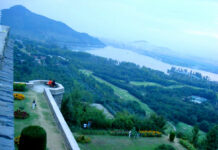After the September 2014 floods that devastated Kashmir, especially the economic hub, the Srinagar, the follow up has been going on quite sluggishly. While the main focus has been, and continues to be, on dredging de-slitting of the main Jhelum River and the Flood Spill Channel that bypasses the river for most of the Srinagar city, there has not been anything other than the state planners can think of.
The dredging has remained a sort of controversy and there have been various issues linking to it, especially the scientific part of it. Nevertheless, it is about to reach the level it was supposed to be. There have been patches of the river which have been taken care of and there are patches hitherto not taken seriously. Dredging was only part of the Rs 399 crore project that central government funded after the devastating floods.
But there are two areas that have not been taken very seriously. One is the Srinagar master plan. The plan though not done properly has witnessed massive interventions in last two years. Some of the interventions are detrimental to the existence of well being of the city as it suggests fundamental shifts in the land use pattern and location of key facilities. The policymakers have deliberately avoided looking at the cost of making investments in the flood basin of the city, both in private and the public sector.
Most of the fresh investments are taking place in Bemina belt and other flood prone areas. Even the embankments of the river are being critically encroached around. A major multi-level complex came up in the flood basin in Rajbagh and nobody took note of it till it was ready.
Even single spot that is available in Srinagar around the chocked channels and water ways has either been encroached upon by the land mafia or the twin developmental agencies – the Srinagar Development Authority or the Srinagar Municipal Corporation. A lot of money is being invested to create infrastructure which is detrimental to the health of the city.
The other major crisis is that the planners do not understand the importance of tackling Wular Lake. This lake is a huge cushion to Kashmir for floods. It is reporting a serious crisis over the years as it has grown shallower and massively encroached upon from all sides by the greedy farmers and the land mafia. The government has created a separate project that would work on it but the work has not started at all. Even if the entire river is cleaned of all the sand and shoals, without improving the capacity of the lake there is no guarantee for safety of Srinagar and the areas downstream. Earlier the lake had the capacity to store almost five days of huge discharge in Jhelum which has reduced to barely one and half day.
Now the authorities say they have engaged an off shore company that will take two years to study the entire drainage set up of Kashmir and suggest a master plan for managing the systems. Managing experts is all right but time is not on the side of the planners or the population living in Kashmir. The climatic change has already started taking over and there is a possibility of an abrupt shift in Kashmir’s 55-year flood cycle. Right now, when the administration lacks any political intervention, the governor’s administration is in a better position to take a call and decide as soon as possible.









